Figure 2-1: The Twitter Grader website.
Finding the Right Metrics Service
What do I mean by service? A metrics service is any program, site, or software that helps you keep track of your metrics. You probably have heard of several: Google Analytics, Facebook Insights, Google+ Ripples, Klout, Twitter Grader, Radian6, MediaVantage (formerly DNA 13), CustomScoop, HootSuite Analytics, and hundreds of other sites and services that would take a chapter of their own to list (and still more would have cropped up by publication time — measurement is a hot topic in social media right now).
In the following sections, I take a look at a few of these metrics by type of measurement or service measured. This list is by no means complete! I’m just taking a snapshot of some of the options available to you right now. These simple tools can get you started with basic metrics.
Hundreds of services claim to measure Twitter metrics and influence. In fact, Twitter itself offers metrics if you’re a brand that pays to advertise on Twitter via their Promoted Tweets, Promoted Topic, and such. However, most smaller brands have trouble swallowing the official Twitter promotion price tag. Until Twitter’s new á la carte affordable ads, which are similar to AdWords, become the norm, you can try a few of these services:
![]() Twitter Grader (
Twitter Grader (http://tweet.grader.com
), made by Boston company HubSpot, is a simple metric to measure your amplification and traction on Twitter (see Figure 2-1). It doesn’t dig very deep, but it will give you a quick snapshot of how you’re doing in your main topic or locality versus others who are similar to you.
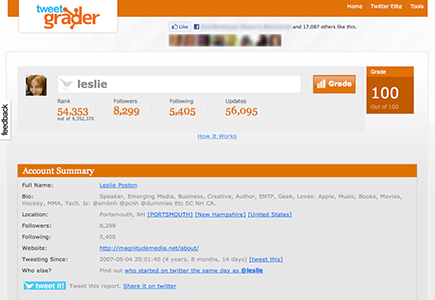
![]() Twitter Score (
Twitter Score (http://twitterscore.info
) is also a single metric score system without much depth. Because Twitter Score is another snapshot service for a quick picture, you’ll need to use other metrics to get a complete idea of the influence or knowledge of the company or person you’re looking at.
![]() Twitalyzer (
Twitalyzer (www.twitalyzer.com
) pulls some great metrics from Twitter and from other measurement services and then arranges them into a visually pleasing and easy-to-understand grid (see Figure 2-2). This setup is a great way get a look at how you’re doing on Twitter and compare your potential reach to your actual reach.
![]() TweetLevel (
TweetLevel (http://tweetlevel.edelman.com
) by Edelman is not a service that I found especially accurate as far as influencers and topics. In fact, it made some of the same errors as Klout (only measuring volume and not going deep enough under the surface), which makes me give it a “use with a grain of salt” rating. I would use these three metrics services in tandem with each other to get a more complete picture of what you’re seeking more info about.
Figure 2-2: The Twitalyzer website.
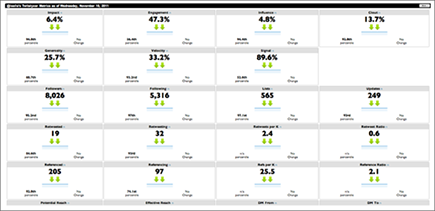
![]() TweetReach (
TweetReach (http://tweetreach.com
) checks only one thing — how far your tweet has travelled — but it’s one very useful thing. Twitter.com is constantly changing how the service handles things like retweeting and how users see favorites, retweets, and follows, so anything that can give you a better, more consistent picture of how far your tweets go after they are launched is a good tool.
![]() Crowdbooster (
Crowdbooster (http://crowdbooster.com
) doesn’t only focus on Twitter; it also pulls in Facebook. However, Crowdbooster is best at analyzing Twitter and telling you the best time of day to tweet and the effectiveness of your last several tweets. It offers a freemium model: free to try for limited accounts and then pay to play for more. In my opinion, the free version is more than enough because the paid version no longer offers detailed reporting.
![]() TweetMeme (
TweetMeme (http://tweetmeme.com
) focuses more on how topics are perceived by others on Twitter. TweetMeme is useful for keyword and trending topic measurement and can help you fine-tune what you’re talking about on Twitter and how you’re talking about it to be most effective.
Facebook actually has a decent set of on-site metrics for folks who use its Pages. Facebook’s metrics don’t look to anything shared outside of the site, but they can give you a surprising overview of the demographics of and interest in your brand online. Drawbacks include a lack of tab-specific tracking and no ad-tracking integration. Facebook keeps Page Insights and Ad Insights in different places. If you want to track your tabs or shares outside of your Page, you’re going to have to get creative or try Crowdbooster (see preceding section) or other Facebook-related tools, like these:
![]() Booshaka (
Booshaka (http://booshaka.com
) is another tool offering the freemium model. Booshaka tells you who the top contributors are to your Facebook Page. This information is useful — if the top contributors are your team and immediate friends, you have some work to do to get the word out about your page!
![]() ShortStack (
ShortStack (http://shortstackapp.com
) is an app that makes Facebook tabs for you and also measures how they’re working. It has a free and a paid version, and even the free version allows you to not only see detailed metrics as they measure them, but to add in Google Analytics, MailChimp Analytics, and more inside each tab for extremely detailed tab monitoring.
![]() Tribemonitor (
Tribemonitor (www.tribemonitor.com
) is relatively new and not isolated to Facebook. It’s in Dutch, but the charts and graphs are clear and easy to read. If you use Google Chrome as your browser, you can automatically translate any site not in your native language (a nifty trick). Tribemonitor gives you a way to track your Facebook fan base and follow it across other networks as well.
YouTube
YouTube is now owned by Google. This means it has some powerful metrics tools under the hood and that you can integrate with Google Analytics (see Figure 2-3). (If you feel like I mention Google Analytics a lot, it’s because I do. Google Analytics can be a powerful, affordable, and versatile weapon in your metrics arsenal.)
To find the YouTube Insight analytics program for your videos, look at www.youtube.com/t/advertising_insight
.
Not too many third-party tools, though, measure YouTube effectively at an affordable price. However, TubeMogul (http://tubemogul.com
), the video uploading service, does offer analytics. It starts with limited stats for free, and then you can access more advanced stats with a paid subscription.
SlideShare
SlideShare is the popular slide-sharing service where people and brands can post their slide decks for viewing online. The company has since added video and documents to its file formats, so you can post your actual speaking videos and sales documents as well. SlideShare becomes more useful by the day.
Although you can post your slides, documents, and videos for free, if you want analytics from SlideShare directly — yep, you guessed it! — you’ll have to buy a paid plan. Luckily, analytics start at about $20 if you’re a business with a robust channel that needs to know how you’re doing on the network, and this paid plan also allows you to overlay a lead capture form on each document (not something that has anything to do with metrics, but a cool feature nonetheless).
No great third-party tool focuses on SlideShare well enough currently to mention here, though I’m sure one will eventually come along, as metrics remains a hot topic. Meanwhile, you can use Google Analytics to track things like SlideShare stats.
LinkedIn is the social network known for its business focus. Whether you’re an individual looking to network or a company that has a page and/or group, LinkedIn can be a valuable social tool. If you have a page for your company, a group, or a personal pro account, LinkedIn also has some pretty detailed metrics for each function (see Figure 2-4). LinkedIn is also rolling out metrics on events in the coming months, and I’m sure they’ll be offering insights site-wide before too long.
Figure 2-3: YouTube Analytics.

Figure 2-4: LinkedIn Analytics.
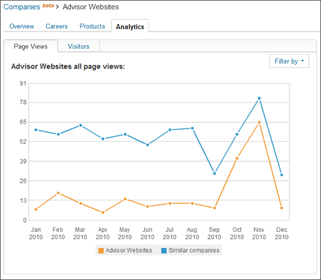
As with SlideShare, there are not really any wonderful tools for measuring LinkedIn. A few services, such as HootSuite, link to it and track some basic things, but few free or freemium services go in depth. However, thanks to the magic of Google search optimizers and shortcuts, you can get some data from Google searches, Google Alerts, and Google Analytics that will be helpful to you.
Google+
That’s right: Big Daddy Google has its own social network now, tied in to many of its other services (As if you needed one more place to keep track of your brand, right?). The happy news here is that amazing statistics come built right in. One of my favorites is their Ripples metric, which tells you per post how the shares (people who found your content valuable enough to reshare to their network) and plus-ones (similar to a Facebook like, but with more depth) grew (see Figure 2-5). When you get someone like Chris Penn or Chris Brogan with hundreds of interactions, the Ripples graph gets very interesting very quickly. I especially like how you can animate the way a post grew in reach. What a great (and addictive) visual tool.
Third-party tools for Google+ include the following:
Figure 2-5: Google+ Ripples.
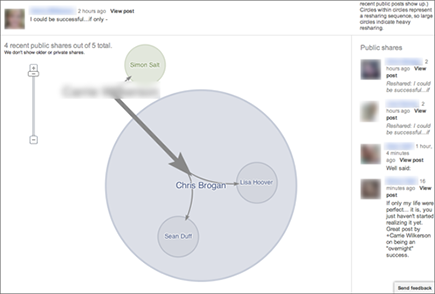
![]() FindPeopleOnPlus (
FindPeopleOnPlus (http://findpeopleonplus.com
): Google+ has a lot of great features and great analytics built right in, but falls oddly short on searching for new users. Because search is Google’s bread and butter, I’m betting it fixes that problem soon. Until that time, FindPeopleOnPlus shows you users by keyword and category in a clean list, along with assigning a number to the influence on Google+ that seems to be based on the karma of being plussed and shared often more than on your number of followers. That’s a number I can support.
![]() SocialStatistics (
SocialStatistics (http://socialstatistics.com
): SocialStatistics, on the other hand, is strictly a popularity contest. If follower counts matter to you (they shouldn’t, by the way), then you’ll like this simple stat service for a quick look at someone’s rank on the service by follower count.
Multiple service simple metrics
Some third-party services claim to measure multiple social sites and services, with varying degrees of success. Here’s s a brief list of that type of metrics service:
![]() PeerIndex (
PeerIndex (www.peerindex.com
): PeerIndex is attempting to be a competitor to Klout, and succeeding. While still too basic to be truly useful, PeerIndex does a much better job than Klout of making rankings and statistics it pulls contextual, so you know what is feeding your number. PeerIndex also has somewhat less invasive privacy practices than Klout, though, like Klout, it also does a little too much digging into the networks of people connected to you who aren’t signed up for the service yet. PeerIndex works with several other sales tools, such as Rapportive, which can come in handy when you need a quick peek at someone’s activity online before making that sales call.
![]() Crowdbooster: I cover Crowdbooster in the section “Twitter,” earlier in this chapter, but it’s a nifty tool to grab the metric of when your tweets, Facebook updates, and Page updates have the most traction in a day.
Crowdbooster: I cover Crowdbooster in the section “Twitter,” earlier in this chapter, but it’s a nifty tool to grab the metric of when your tweets, Facebook updates, and Page updates have the most traction in a day.
Remember, I touched on only a handful of tools here to get you started thinking of social media as something you can measure (and measure in new and intriguing ways). None of the metrics tools I list are intended to be used as stand-alone solutions, by any means. In fact, no one tool really rules when it comes to metrics. You need to have at least two, and maybe more, in place to get the complete picture that measures all the different ways you can see impact and reach online.
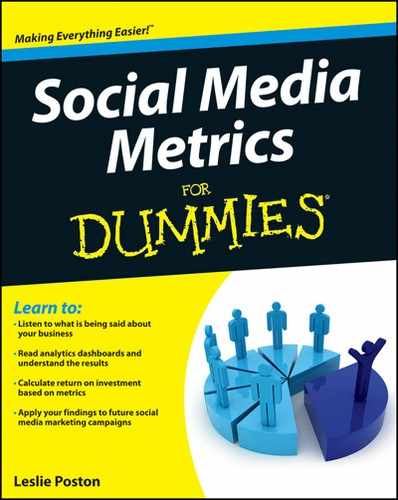
 You may see a trend in
You may see a trend in